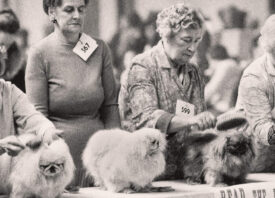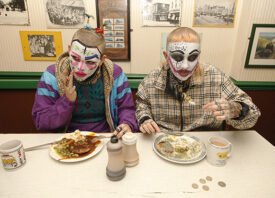Search this site
‘Women, Children and Loitering Men’: A Glimpse at Manchester’s Slums in the 1960s
Manchester, 1968, © Shirley Baker Estate, Courtesy of Mary Evans Picture Library
Hulme, July 1965, © Shirley Baker Estate, Courtesy of the Shirley Baker Estate
Manchester, 1967, © Shirley Baker Estate, Courtesy of the Shirley Baker Estate
In the 1960s and the two decades following, the streets of the Manchester slums became like a home away from home for British street photographer Shirley Baker (1932-2014), whose middle class family owned a furniture store in Salford. As children played on concrete roads, their parents watched as terraced homes were razed to the ground in favor of new developments.
According to the curator Anna Douglas, whose exhibition Shirley Baker: Women, Children and Loitering Men is now on view at The Photographers’ Gallery in London, Baker is recognized as the sole female photojournalist working in the streets of Britain during the post-war decades. Inner city Manchester and Salford became her constant subject in the mid-20th century, when she witnessed the beginnings of the demolitions that would sweep the area, forcing large families from their already small living quarters and into illegal squats. Cranes leveled the blocks, and houses were evacuated and left vulnerable to break-ins and vandalisms by neighborhood kids.
These streets and their homes, erected to house the working class families that sent their mothers and fathers to labor in nearby factories, were heavily affected by the time Baker began photographing them. Bricks were painted in a layer of soot, and drinking water was no longer clean. There was little space to make a home and none for children to play, and yet youngsters spilled out into the streets in groups to congregate and frolic about with their toys. It was the children who most loved Baker; when she arrived, camera in hand, they circled her and pleaded that she take their picture.
The scenes captured in Baker’s gaze no longer persist; in fact, the apartments that replaced them have since been substituted with newer housing. For Douglas, however, these images escape relegation to the realm of wistfulness or sentimentality; instead, they reach through the decades to touch on themes and characters that carry weight and meaning today. Yes, they are documentary images, but for Douglas, they can also be symbolic ones, those that speak to an abiding vigor and resilience of the human spirit.
Shirley Baker: Women, Children and Loitering Men is on view until September 20th, 2015.

Hulme, 1965, © Shirley Baker Estate, Courtesy of Mary Evans Picture Library

Hulme, July 1965, © Shirley Baker Estate, Courtesy of the Shirley Baker Estate

Hulme, May 1965, © Shirley Baker Estate, Courtesy of the Shirley Baker Estate

Manchester, 1964, © Shirley Baker Estate, Courtesy of Mary Evans Picture Library

Near Upper Brook St, Manchester, 1964 © Shirley Baker Estate, Courtesy of Mary Evans Picture Library
All images © Shirley Baker
via The Guardian






